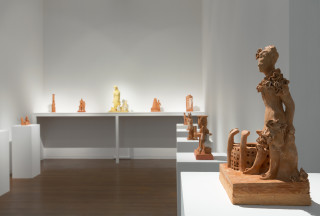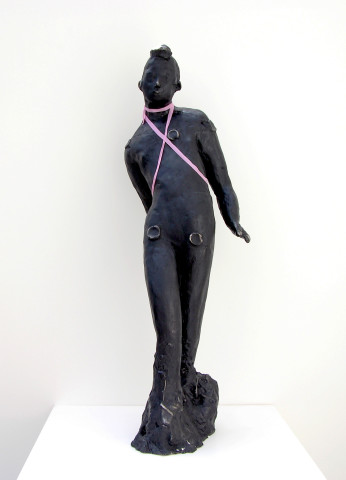All eloquence, the sculptures in Figure sculpture lean, have torsion, cock their heads or shyly twist a foot. Observations from Marrinon’s anthropological archaeology of human nature. Character, previously given in her sculptural work by facial expression (a raised eyebrow) and dress, has become amplified by posture.
Exhibition Dates: 6 April – 30 April 2006
Plaster casts of the human body or its representation have played a crucial role in the history of European figurative sculpture since Roman connoisseurs first admired the artistic achievements of their Greek predecessors and wanted to take a copy of their expression of ennobled humanity. These casts permitted the transmission of an ideal across centuries and continents and became staple items in Masters’ studios, the Academies and first museums. Linda Marrinon is an artist who was famous in the early 1980s for her resolutely a-technical, cartoon-like paintings of human foible and frustration. So it might seem strange to now find her producing sculpture in such a definitely traditional, skilled-up manner as is apparent in the group of cast plaster works in her exhibition, Figure sculpture, at Roslyn Oxley9 Gallery.
Until now, Marrinon’s audience has seen only her clay and terracotta sculptures of figures and scaled-down public monuments which she has been making since the early 1990s. With these works, she managed in her inimitable, economical way to pull coy sentience and character from dumb clay. Compared with the plaster works, the clay ones had a definite earthboundness. Limbs clung to torsos and the whole caboodle was decidedly, somehow doubly gravity prone—a part of their irresistible charm. The catalyst for the current work was a stint of study as part of a Samstag Fellowship at the New York Academy of Art in New York—an institution that is a seeming anachronism in the world of conceptual art, the likes of which does not really exist in Australia these days. At the Academy, Marrinon was tutored in “the perceptual and conceptual means to construct the human figure in two or three dimensions from the model or from memory. [Examination of] the body's structure through the study of appropriate principles of the mechanics of motion, surface form and human anatomy [with particular emphasis on] the proportions of the skeleton, the major body masses, and the movement potential in the joints.”
With this learning evolved a vocabulary for a newly articulate body language in Marrinon’s work. Their new skeletal structure and uprightness (given by a supportive, spine-like armature), gave them the wherewithal to exploit the partly-self-conscious partly-unself-conscious capacity for posing and deportment that is a distinctly human trait. All eloquence, the sculptures in Figure sculpture lean, have torsion, cock their heads or shyly twist a foot. Observations from Marrinon’s anthropological archaeology of human nature. Character, previously given in her sculptural work by facial expression (a raised eyebrow) and dress, has become amplified by posture. But still Marrinon dresses her mini pantheon with humour. Their wardrobe of accessories—cravats, hats, buttons etc—also have their say, externalizing clues about the identity, character, ego within the given human frame.
—Amanda Rowell
—
Linda Marrinon has been exhibiting with Roslyn Oxley9 Gallery since 1983. In 2001 a solo exhibition of her paintings and sculptures was held at the Ian Potter Museum in Melbourne. Also in 2001, Marrinon was a recipient of the prestigious Samstag Fellowship which permitted her to study at the New York Academy of Art. Museum exhibitions include Australian Perspecta (1983 and 1999) as well as Wit’s end (1993) and Word (1999), both at the Museum of Contemporary Art, Sydney as well as many other significant museum exhibitions in . Marrinon’s paintings and sculptures are held by the Art Gallery of South Australia, the National Gallery of Victoria and the Museum of Contemporary Art, Sydney and numerous private and corporate collections in . A monograph on Marrinon, written by Chris McCauliffe, is currently in production as part of the Craftsman House New Art Series. Figure sculpture is Marrinon’s seventh solo exhibition with Roslyn Oxley9 Gallery.
 Linda Marrinon All hail Tony Duquette!
Linda Marrinon All hail Tony Duquette!
Roslyn Oxley9 Gallery, 2024
 Group Show, The First 40 Years
Group Show, The First 40 Years
Roslyn Oxley9 Gallery, 2024
 Group Show, The Winter Bride
Group Show, The Winter Bride
Roslyn Oxley9 Gallery, 2023
 Linda Marrinon Pierre Fresnay and other sculptures
Linda Marrinon Pierre Fresnay and other sculptures
Roslyn Oxley9 Gallery, 2023
 Linda Marrinon Scene at Edfu and other sculptures
Linda Marrinon Scene at Edfu and other sculptures
Roslyn Oxley9 Gallery, 2020
 Group Show, On Vulnerability and Doubt
Group Show, On Vulnerability and Doubt
Australian Centre for Contemporary Art, Melbourne, 2019
 Linda Marrinon The National
Linda Marrinon The National
Art Gallery of New South Wales, Sydney, 2019
 Linda Marrinon
Linda Marrinon
Roslyn Oxley9 Gallery, 2019
 Linda Marrinon Architects! Terracotta!
Linda Marrinon Architects! Terracotta!
Roslyn Oxley9 Gallery, 2018
 Linda Marrinon
Linda Marrinon
Roslyn Oxley9 Gallery, 2016
 Linda Marrinon Figure Sculpture 2005-2015
Linda Marrinon Figure Sculpture 2005-2015
Monash University Museum of Art, Melbourne, 2015
 Linda Marrinon Plaster Busts, 2014
Linda Marrinon Plaster Busts, 2014
Roslyn Oxley9 Gallery, 2014
 Linda Marrinon Figure Sculpture
Linda Marrinon Figure Sculpture
Roslyn Oxley9 Gallery, 2011
 Linda Marrinon Figure Sculpture
Linda Marrinon Figure Sculpture
Roslyn Oxley9 Gallery, 2009
 Group Show, Lucky Town
Group Show, Lucky Town
Roslyn Oxley9 Gallery, 2008-09
 Linda Marrinon Figure Sculpture II
Linda Marrinon Figure Sculpture II
Roslyn Oxley9 Gallery, 2008
 Group Show, STOLEN RITUAL
Group Show, STOLEN RITUAL
Roslyn Oxley9 Gallery, 2006-07
 Linda Marrinon Figure Sculpture
Linda Marrinon Figure Sculpture
Roslyn Oxley9 Gallery, 2006
 Linda Marrinon
Linda Marrinon
Roslyn Oxley9 Gallery, 2003
 Group Show, All Stars
Group Show, All Stars
Roslyn Oxley9 Gallery, 2000
 Linda Marrinon Sculpture For The Home
Linda Marrinon Sculpture For The Home
Roslyn Oxley9 Gallery, 2000
 Linda Marrinon Linda Marrinon Sculptures
Linda Marrinon Linda Marrinon Sculptures
Roslyn Oxley9 Gallery, 1999
 Linda Marrinon Landscapes
Linda Marrinon Landscapes
Roslyn Oxley9 Gallery, 1996
 Group Show, Stockroom
Group Show, Stockroom
Roslyn Oxley9 Gallery, 1995
 Linda Marrinon Sculpture
Linda Marrinon Sculpture
Roslyn Oxley9 Gallery, 1994
 Group Show, High pop
Group Show, High pop
Roslyn Oxley9 Gallery, 1993
 Linda Marrinon
Linda Marrinon
Roslyn Oxley9 Gallery, 1991
 Linda Marrinon
Linda Marrinon
Roslyn Oxley9 Gallery, 1987
 Group Show, Chaos
Group Show, Chaos
Roslyn Oxley9 Gallery, 1987
















